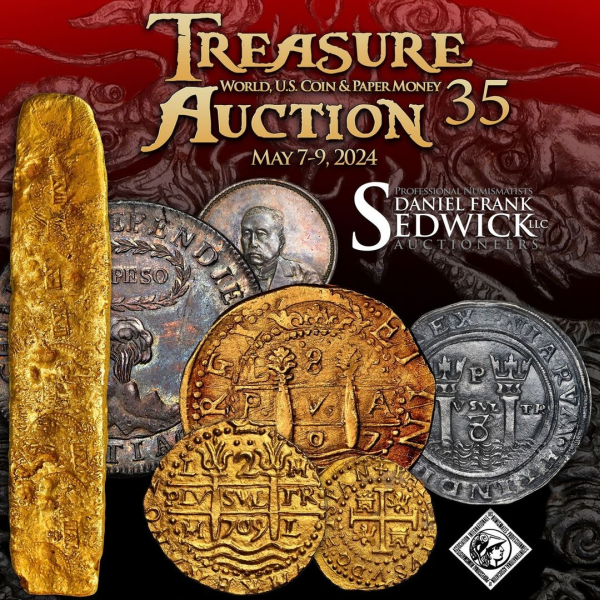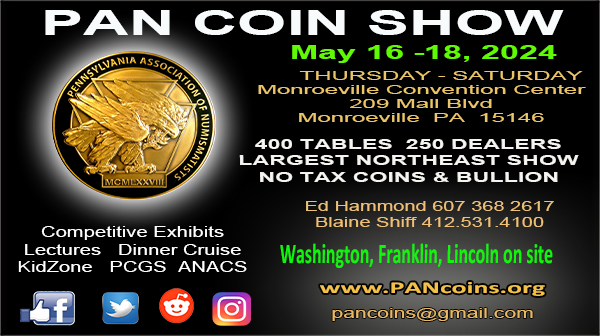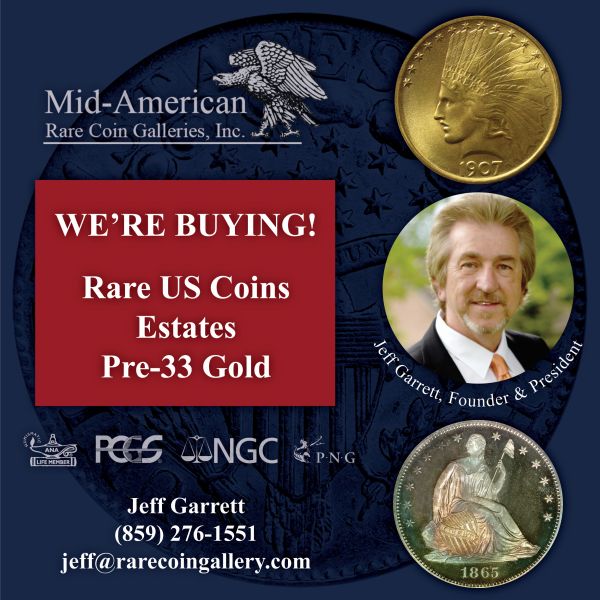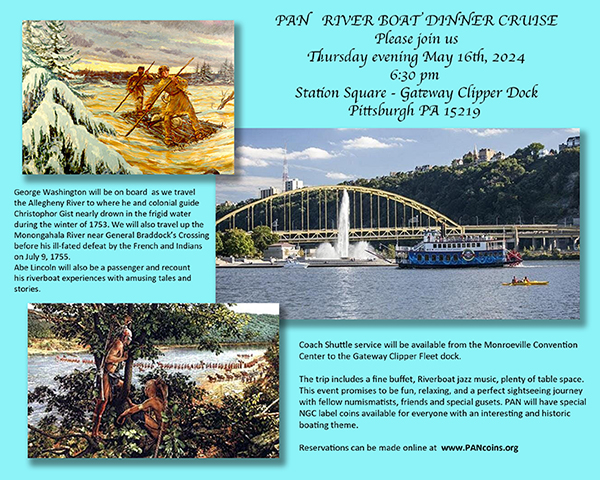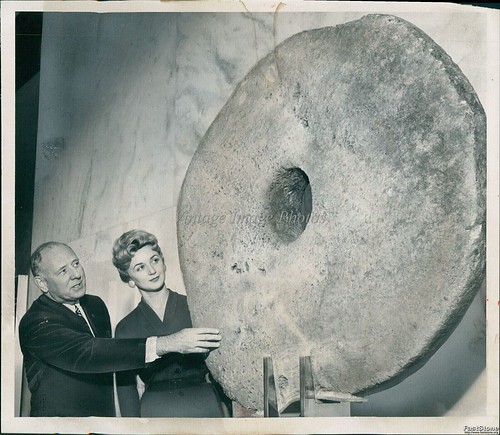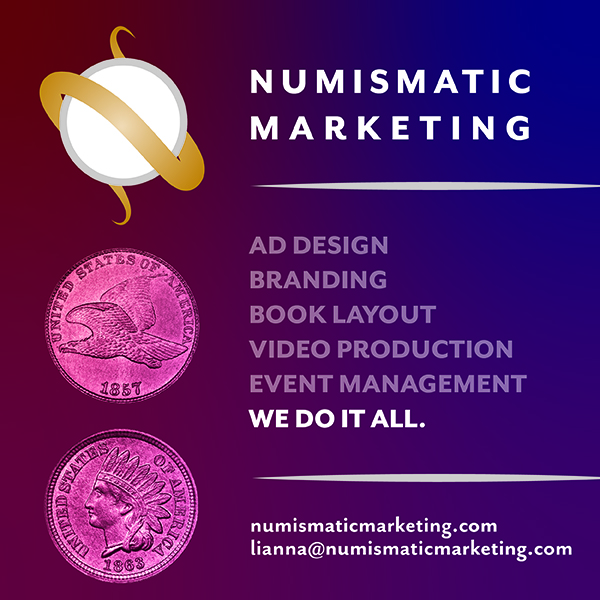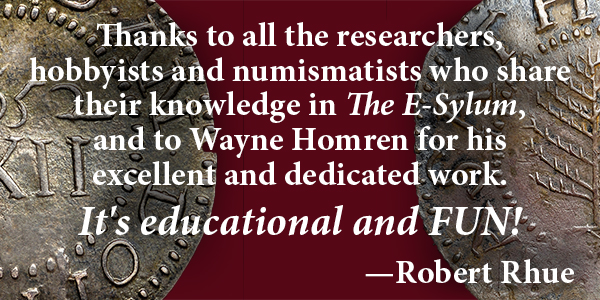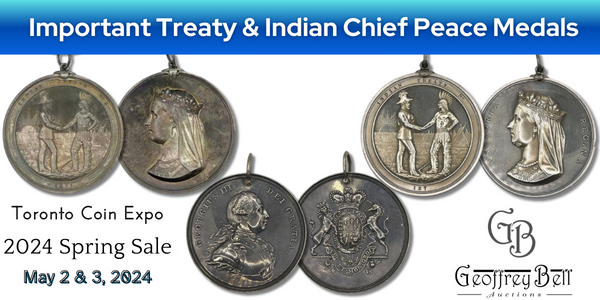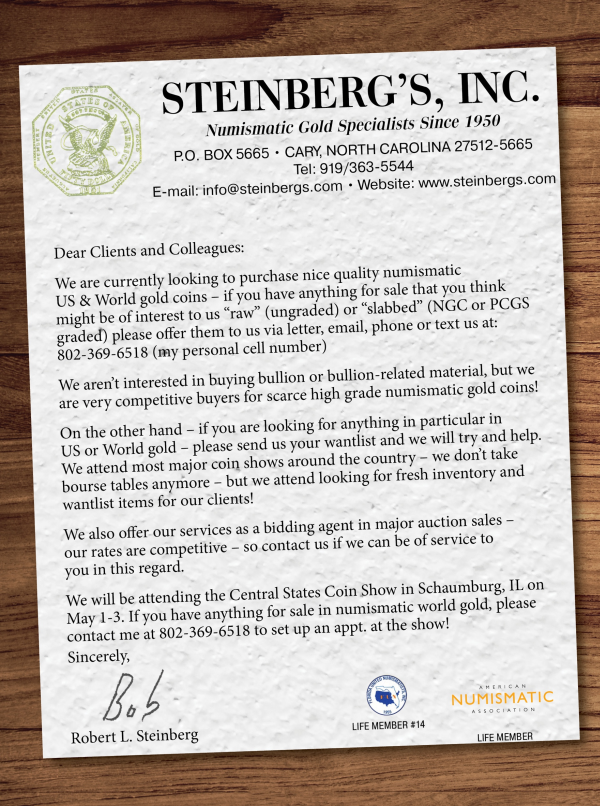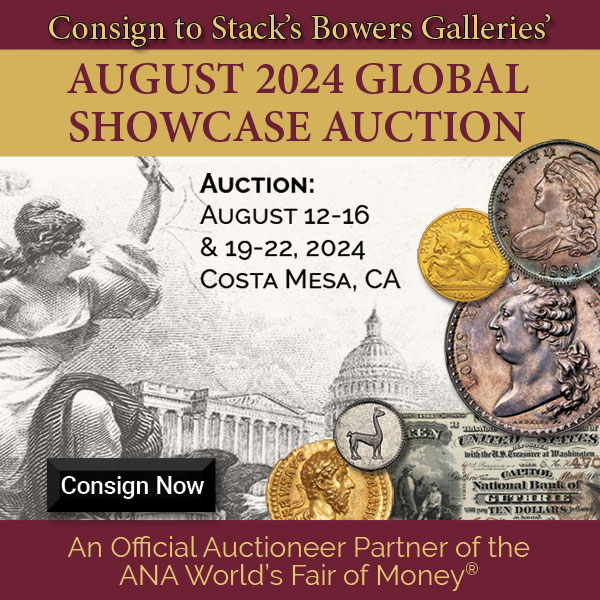
Visit our NBS Sponsors
About UsThe Numismatic Bibliomania Society is a non-profit association devoted to the study and enjoyment of numismatic literature. For more information please see our web site at coinbooks.org SubscriptionsThose wishing to become new E-Sylum subscribers (or wishing to Unsubscribe) can go to the following web page link MembershipThere is a membership application available on the web site Membership Application To join, print the application and return it with your check to the address printed on the application. Print/Digital membership is $40 to addresses in the U.S., and $60 elsewhere. A digital-only membership is available for $25. For those without web access, write to: Jeff Dickerson, Treasurer AsylumFor Asylum mailing address changes and other membership questions, contact Jeff at this email address: treasurer@coinbooks.org SubmissionsTo submit items for publication in The E-Sylum, write to the Editor at this address: whomren@gmail.com BUY THE BOOK BEFORE THE COIN |
- WAYNE'S WORDS: THE E-SYLUM APRIL 28, 2024
- CHRISTOPHER CHALLIS NUMISMATIC LIBRARY
- NEW BOOK: GOLD COINAGE OF THE LOW COUNTRIES
- NEW BOOK: COLONIALISM'S CURRENCY
- BANKNOTE BOOK GREECE CHAPTER PUBLISHED
- PERIODICAL: NUMISMATIQUE ASIATIQUE NO. 49
- BOOK REVIEW: 100 GREATEST ANCIENT COINS, 3RD ED.
- VIDEO: WHY BOGGS? WHY NOW?
- VIDEO: HISTORY OF DIE MAKING IN THE U.S.
- NOTES FROM E-SYLUM READERS: APRIL 28, 2024
- 2025 AMERICAN LIBERTY DESIGNS
- VOCABULARY TERM: PLANCHET
- NUMISMATIC EXHIBITIONS AT U.S. BANKS
- THE INFAMOUS GROUX COLLECTION
- ATLAS NUMISMATICS SELECTIONS: APRIL 28, 2024
- SEDWICK OFFERS FIVE POUND ATOCHA GOLD BAR
- NOONAN'S OFFERS OLYMPIC MEDALS
- BANKNOTES OF THE DEUTSCH-ASIATISCHE BANK
- NUMISMATIC NUGGETS: APRIL 28, 2024
- SWEDISH ISLAND SILVER BRACTEATE HOARD
- EURO COIN COUNTERFEITERS CAUGHT
- EURO BOOK COUNTERFEITERS CAUGHT
- BOY REBUILDS SHREDDED 10,000 YEN BILL
- LOOSE CHANGE: APRIL 28, 2024
- FEATURED WEBSITE: ROCHESTER NUMISMATIC ASSOCIATION
Content presented in The E-Sylum is not necessarily researched or independently fact-checked, and views expressed do not necessarily represent those of the Numismatic Bibliomania Society.
WAYNE'S WORDS: THE E-SYLUM APRIL 28, 2024
 New subscribers this week include:
Pamela Herrick,
Curator of Gilroy Roberts Collection at Community College of Philadelphia;
Welcome aboard! We now have 7,271 subscribers.
New subscribers this week include:
Pamela Herrick,
Curator of Gilroy Roberts Collection at Community College of Philadelphia;
Welcome aboard! We now have 7,271 subscribers.
Thank you for reading The E-Sylum. If you enjoy it, please send me the email addresses of friends you think may enjoy it as well and I'll send them a subscription. Contact me at whomren@gmail.com anytime regarding your subscription, or questions, comments or suggestions about our content.
This week we open with a numismatic literature fixed price list, three new books, a periodical issue, a book review, updates from the Newman Numismatic Portal, and more.
Other topics this week include gold coinage of the Low Countries, money artist J.S.G. Boggs, die making in the U.S., planchets, numismatic exhibitions at banks, the Groux collection, fixed price and auction offerings, Olympic medals, coin and book counterfeiters, and the Rochester Numismatic Association.
To learn more about Dr. Christopher Challis, the formation of Canadian money, the 100 greatest ancient coins, Greek banknotes, Spanish money in the Eastern European colonies, a 50-year button search, 2025 silver American Liberty designs, the protesting nymph, a 400-year-old gold bar, the Art Directors Club medal, J.N.T. Levick, the old receipt weirdo and Verminus, the god of cattle worms, read on. Have a great week, everyone!
Wayne Homren
Editor, The E-Sylum
CHRISTOPHER CHALLIS NUMISMATIC LIBRARY
Mitch Fraas passed along notice of a numismatic literature price list from York, UK bookseller Ken Spelman. Thanks. Here are a few selections. -Editor
Ken Spelman - Short List 31
Here is the next in an occasional series of short-lists. Coinage History - Books from the Library of Dr Christopher Challis.
Dr C. Challis (1939-2021), was a leading specialist in Tudor coinage and mint operations, and wrote The Tudor Coinage – 1978, A New History of the Royal Mint (Ed.) - 1992, and published many papers. He edited the British Numismatic Journal for many years.
AGRICOLA, Georgius. De Re Metallica. Translated by Herbert Clark Hoover and Lou Henry Hoover. 638pp., illustrations. A very good hardback copy in slightly edge worn dust-wrapper. Some dustiness to edge of the book block.
large 8vo. Dover. c1975.
£15.00
COOPER, Denis R. The Art and Craft of Coinmaking. A History of Minting Technology. 264pp., 262 illustrations (some in colour). A very good hardback copy. Very scarce.
4to. Spink and Son. 1988.
£120.00
McDONALD, Donald, and Hunt, Leslie B. A History of Platinum and its Allied Metals. 450pp., illustrations. A very good hardback copy in dust-wrapper.
large 8vo. Johnson Matthey. 1982.
£15.00
REDDAWAY, T.F., and Walker, Lorna E.M. The Early History of the Goldsmiths’ Company 1327-1509 including The Book of Ordinances 1478-83. 378pp., plates. A very good hardback copy in dust-wrapper. Ownership name of C.E. Challis on the end-paper.
8vo. Edward Arnold. 1975.
£20.00
ROBINSON, Brian. Silver Pennies & Linen Towels. The Story of the Royal Maundy. 273pp., 118 illustrations. A very good hardback copy in dust-wrapper which has some fading on the rear panel. Inscribed on the end-paper: To Dr C.E. Challis. With many thanks for the significant contribution that, through your expertise, you made to this book. Brian Robinson.
Scarce.
large 8vo. Spink. 1992.
£45.00
WOODHEAD, Peter. The Herbert Schneider Collection, Volume 1 - English Gold Coins 1257-1603. xiii, 463pp. A very good hardback copy in dust-wrapper. Inscribed on the end-paper: Christopher, with grateful thanks for your personal help, and in appreciation of all you have published which has been so essential in compiling this book. Peter.
large 8vo. Spink and Son. 1996.
£35.00
For more information, or to order, see:
Ken Spelman Books Ltd
(https://www.kenspelman.com/)
NEW BOOK: GOLD COINAGE OF THE LOW COUNTRIES
Hugo Vanhoudt and John Sanders have published a new book on the gold coinage of Belgium, Luxembourg and The Netherlands. -Editor
(from 3th Cent. BC to present)
by Hugo Vanhoudt / John Saunders
LUXEMBOURG
THE NETHERLANDS
 This book gives a complete overview of all the gold coins and special
issues in gold produced on the territory of present-day Belgium,
Luxembourg and The Netherlands and Overseas territories, from the
Celts to 2022.
This book gives a complete overview of all the gold coins and special
issues in gold produced on the territory of present-day Belgium,
Luxembourg and The Netherlands and Overseas territories, from the
Celts to 2022.
A description on 2000 illustrated gold coin types, including special issues as patterns and off-metal strikes, with details of their obverse, reverse, edge, weight, fineness and rarity, and prices per date for different grades.
440 pages (29,7 x 21.0 cm),
fully illustrated in color, hardboard cover.
ISBN 978-1-7356598-1-7
Hugo adds:
"In June 1963, Mr. A. Delmonte wrote in the foreword to his book The Golden Benelux: ‘We hope that the publication of this book will stimulate the already intensive collecting of the coins of our provinces and that this book may help both current and future interested parties to get a complete overview of the golden and rich numismatic past’. These words were more than realized and were the main reason for this publication. series of gold coins.
"Each gold coin is a precious, artistic and attractive historical document to everyone’s eye. Especially for local history, these golden pieces can represent a story of wars, international contacts and exceptional economic prosperity as well as hard times. With their artistic designs, some medieval coin series are among the most beautiful in Europe and are highly sought for.
"This book is designed for collectors and dealers. The book gives an overview of all types of gold coins that have been produced in the Low Countries over the past 23 centuries. The demarcation of the scope and the terrain has led to the title The Gold Coinage of the Low Countries. The borders of countries and regions have undergone major changes during this period, as a result of which the inclusion or exclusion of certain coins has sometimes been arbitrary. the local rulers mainly on the current territory of the Benelux (Belgium, Luxembourg and The Netherlands) and some in the Northern part of France."
Price: 100 euro, excluding shipment
Packaging and postage within
- Belgium: 15 euro
- EEC: 20 euro
- other countries: on demand
To order, please send E-mail to Hugo Vanhoudt vanhoudt.hugo@gmail.com
NEW BOOK: COLONIALISM'S CURRENCY
Well, not new actually, but new to us - we haven't covered this 2020 book yet in The E-Sylum. I learned about it through a review by Jesse Kraft in the 2024 issue 1 of ANS Magazine from the American Numismatic Society. -Editor
Colonialism's Currency
Money, State, and First Nations in Canada, 1820-1950
By Brian Gettler
Money, often portrayed as a straightforward representation of market value, is also a political force, a technology for remaking space and population. This was especially true in nineteenth- and twentieth-century Canada, where money - in many forms - provided an effective means of disseminating colonial social values, laying claim to national space, and disciplining colonized peoples.
Colonialism's Currency analyzes the historical experiences and interactions of three distinct First Nations - the Wendat of Wendake, the Innu of Mashteuiatsh, and the Moose Factory Cree - with monetary forms and practices created by colonial powers. Whether treaty payments and welfare provisions such as the paper vouchers favoured by the Department of Indian Affairs, the Canadian Dominion's standardized paper notes, or the "made beaver" (the Hudson's Bay Company's money of account), each monetary form allowed the state to communicate and enforce political, economic, and cultural sovereignty over Indigenous peoples and their lands. Surveying a range of historical cases, Brian Gettler shows how currency simultaneously placed First Nations beyond the bounds of settler society while justifying colonial interventions in their communities.
Testifying to the destructive and the legitimizing power of money, Colonialism's Currency is an intriguing exploration of the complex relationship between First Nations and the state.
In his review Jesse writes:
"This book should be considered essential to the libraries of those interested in Canadian money, as it is one of the few academic approaches to the formation of Canadian money through the nineteenth and twentieth centuries, giving a multidisciplinary historian's approach to a numismatic topic. I would also recommend it to those who study money and value in a broader sense. While the book is situated in a specific time and place, the theories and methods used in the analysis and discussion can be used to compare and contrast the introduction of a new unit of value to any other civilization or society."
For more information, or to order, see:
Colonialism's Currency: Money, State, and First Nations in Canada, 1820-1950
(https://www.history.utoronto.ca/research-publications/faculty-publications/colonialisms-currency-money-state-and-first-nations#)
Colonialism's Currency
(https://www.mqup.ca/colonialism-s-currency-products-9780228001171.php)
Colonialism's Currency: Money, State, and First Nations in Canada, 1820-1950 (Volume 39) (Studies on the History of Quebec) Paperback – July 16, 2020
(https://www.amazon.com/Colonialisms-Currency-Nations-Canada-1820-1950/dp/0228001188)
BANKNOTE BOOK GREECE CHAPTER PUBLISHED
A new chapter of The Banknote Book has been published by Whitman-CDN. Written by Tristan Williams and Owen Linzmayer, the 146-page catalog covers 1,273 varieties of Greek notes issued from 1822 – 1998. -Editor
To read the complete article, see:
Greece chapter now available
(https://banknotenews.com/?p=43687)
PERIODICAL: NUMISMATIQUE ASIATIQUE NO. 49
Here are the contents of the latest 86-page issue of Numismatique Asiatique. -Editor
Numismatique ibérique
Iberian numismatics
SPECIAL NUMBER
SPANISH COINS IN THE EAST INDIES
La circulation de l'argent espagnol dans les colonies européennes d'Orient
The circulation of Spanish money in the Eastern European colonies
by Pedro Damián Cano Borrego
Contremarques chinoises sur monnaies espagnoles
Chinese countermarks on Spanish coins
by José Antonio de la Fuente
La monnaie dans la Capitainerie générale des Philippines (XVIe-XVIIIe siècles)
Coinage in the Captaincy General of the Philippines (16th-18th centuries)
by Pedro Damián Cano Borrego
La circulation et l'influence des monnaies espagnoles au Cambodge
The circulation and influence of Spanish currencies in Cambodia
by Alain Escabasse
Les monnaies du San Diego (1600)
The coins of San Diego (1600)
by Christian Charlet
For more information, or to order, see:
https://sites.google.com/site/societedenumismatiqueasiatique/revue
BOOK REVIEW: 100 GREATEST ANCIENT COINS, 3RD ED.
Mike Markowitz wrote a review of the new edition of Whitman's 100 Greatest Ancient Coins for CoinWeek. Here's an excerpt - see the complete article online. -Editor
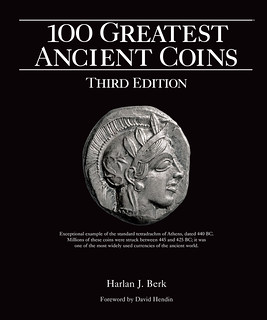 Whitman Publishing produces a series of
Whitman Publishing produces a series of 100 Greatest
coin books, including classic U.S., modern U.S., modern World, U.S. Errors, Canadian coins and tokens, and Women on Coins. Harlan Berk was the perfect author to tackle the challenge of selecting and documenting the 100 Greatest Ancient Coins. In 2008, Berk published the 131-page first edition of this richly illustrated large-format book. A revised second edition of 138 pages appeared in 2019. The first two editions sold out. This new third edition runs to 152 pages with much new content.
The choice of the 100 greatest ancient coins
and their ranking was based on a survey of museum curators, classical scholars, dealers, and collectors. There was a high degree of consensus among the experts. Rather more than 100 individual coins are pictured and described, because some of the categories, such as Coinage of Croesus
(#9) and Athens tetradrachm
(#38) include multiple types. Thirty-eight of the coins are Roman; six are Byzantine; and the rest could be loosely categorized as Greek
, including Phoenician, Carthaginian, and Judean issues.
Some of these coins are great rarities, with only two or three known examples (#22 the Aetna tetradrachm struck in Sicily in 476 BCE is unique, with just a single example held by the Belgian royal library). Others are quite common, with thousands or even millions of surviving pieces, such as #20, the silver tetradrachm of Alexander the Great (ruled 336 – 323 BCE) struck in vast quantities from the tons of bullion he captured from the treasure cities of the Persian Empire, and which continued to be issued in his name from many mints for over a century after his death.
Of the 100 greatest ancient coins, 17 have images of horses; five depict lions; and nine feature eagles. Only one (#25, Hannibal Coin, c.230-220 BCE
) shows an elephant. Forty-five depict actual male rulers (rather than gods) while just 10 show actual historic women (rather than goddesses). Nike, the goddess of victory, is the deity who appears most frequently, followed by Zeus, Athena, Apollo, Poseidon, Mars, and the demigod Herakles. The current record holder for the highest price paid for an ancient at auction is #39 Panticapaeum Gold Stater, c. 340 BCE. A superb example of this coin brought $4,860,267 USD in a 2023 Swiss auction.
The layout and design of this book is superb, with thoughtful use of color and typography. At the bottom of each entry, there is a timeline that locates that specific issue in the span of 20 centuries. There is a good index, a bibliography, a glossary of numismatic terms, and a seven-page Gallery
that displays all the coins in their actual sizes. There is also a gallery of examples of different denominations: 21 Greek, 13 Roman, and 22 Byzantine, including many types that are not among the 100 greatest.
To read the complete article, see:
First Read: 100 Greatest Ancient Coins, Third Edition
(https://coinweek.com/first-read-100-greatest-ancient-coins-third-edition/)
To read the earlier E-Sylum article, see:
NEW BOOK: 100 GREATEST ANCIENT COINS, 3RD ED.
(https://www.coinbooks.org/v26/esylum_v26n50a05.html)
THE BOOK BAZARRE
VIDEO: WHY BOGGS? WHY NOW?
The latest addition to the Newman Numismatic Portal is a video of my recent talk on money artist J.S.G. Boggs. Project Coordinator Len Augsburger provided the following report. -Editor
Wayne Homren Speaks on J. S. G. Boggs
Our E-Sylum editor Wayne Homren presented on April 3 at Washington University in St. Louis on the performance artist J. S. G. Boggs (1955-2017). Boggs was well known for exchanging obvious imitations of paper money for goods and services. His work was equally pursued by collectors and law enforcement, which remained perpetually vexed in its effort to convict an artist who never represented his work as legal tender. Wayne’s talk was held in conjunction with the current numismatic exhibit at Washington University, Coins Across Time: Ancient to American Numismatics. This exhibit, in the Newman Tower portion of Olin Library, runs through July 7.
In my talk I discuss the origin and arc of Boggs' career, and why he's still relevant today. As much a philosopher as an artist, Boggs was decades ahead of his time with thoughts on paper money design, the coming of electronic money, and the nature of money itself. -Editor
Link to Wayne Homren video:
https://www.youtube.com/watch?v=NxORG48J1N0
VIDEO: HISTORY OF DIE MAKING IN THE U.S.
The David Lisot Video Library on the Newman Numismatic Portal can be found at:
https://nnp.wustl.edu/library/multimediadetail/522852
We highlight one of his videos each week in The E-Sylum. Here's one from 2005 about die making in the United States. -Editor
Learn about what was required to make America's earliest money including:
- Concern of the Mint for quality of their coinage
- Challenge of coin die production
-
 Discovery of a Bust half die dated 1809 and the information learned from it
Discovery of a Bust half die dated 1809 and the information learned from it
- Al Overton and his research on Bust halves
- Handwork on early coin dies and how they were produced
- Innovation of the reducing lathe
- The progression of hubbing and reduction of hand punching
- History of alloys and processing methods for steel
Speaker(s): Christopher Pilliod.
To watch the complete video, see:
History of Die Making in the United States
(https://nnp.wustl.edu/library/book/557185)
NOTES FROM E-SYLUM READERS: APRIL 28, 2024
On Eponymous Numismatic Classifications
Len Augsburger of the Newman Numismatic Portal writes:
"Below is an excerpt from the forthcoming bibliography of Eric P. Newman’s publications, the draft of which is up to 138 pages."
Newman 36. Foreword to America’s Foreign Coins: An Illustrated Standard Catalogue with Valuation of Foreign Coins with Legal Tender Status in the United States, 1793-1857, by Oscar D. Schilke and Raphael E. Solomon, IX-X. New York: The Coin and Currency Institute, Inc., 1964.
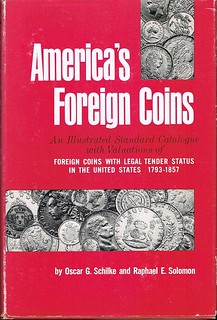 Newman opens by remarking on how inconceivable it is that it took the United States Mint 67 years — from 1793 until 1857 — to replace foreign coinage in circulation with United States coinage. He underscores that, prior to the American Revolution, what little gold and silver that circulated in the American colonies consisted of foreign, not British, coinage. The adoption of the Spanish silver dollar as the U.S. coinage unit after the Revolution was hoped to be a temporary expedient, with the switch over to a decimal system of American coinage hoped to be accomplished soon, but unforeseen problems and unexpected developments kept foreign coinage in circulation for three generations. Newman closes by reminding the reader that this book does not cover the minor coinage that never attained legal tender status: everything ranging from English halfpence (genuine and counterfeit) to American state coinages to Nova Constellatio coppers and Fugio cents.
Newman opens by remarking on how inconceivable it is that it took the United States Mint 67 years — from 1793 until 1857 — to replace foreign coinage in circulation with United States coinage. He underscores that, prior to the American Revolution, what little gold and silver that circulated in the American colonies consisted of foreign, not British, coinage. The adoption of the Spanish silver dollar as the U.S. coinage unit after the Revolution was hoped to be a temporary expedient, with the switch over to a decimal system of American coinage hoped to be accomplished soon, but unforeseen problems and unexpected developments kept foreign coinage in circulation for three generations. Newman closes by reminding the reader that this book does not cover the minor coinage that never attained legal tender status: everything ranging from English halfpence (genuine and counterfeit) to American state coinages to Nova Constellatio coppers and Fugio cents.
Newman accepted Schilke and Solomon’s offer to write a preface in correspondence dated May 10, 1962. In a follow up letter on May 23, Newman weighed in on eponymous numismatic classifications: I believe it is immodest for you to refer to ‘S. S.’ numbers in your own book. That is for others do to.
Newman practiced what he preached. He did not introduce Newman
nomenclature in his work on Fugios (1949), Continental dollars (1952) American Plantations tokens (1955), or Virginia coppers (1956). However, numismatists today commonly use the Newman
term when referring to die varieties within these series. Schilke and Solomon took Newman’s advice, and the final version included only numbered (and not named) varieties.
To read the earlier E-Sylum article, see:
OSCAR GOTTLIEB SCHILKE (1903-1965)
(https://www.coinbooks.org/v27/esylum_v27n16a13.html)
The Grading Scale is NOT Quantitative
Bill Eckberg writes:
 "With respect to the GPT-4 update, there are some things that need to be pointed out. First of all, for the many who don’t seem to understand it, the grading scale is NOT quantitative. It was an attempt to predict the prices of early US cents in the 1940s, and it has never done so effectively. Each grade actually represents a category, not a numerical value. A 40 coin is an XF, and that does not mean it is 40/70 from a perfect coin, 40/60 from a Mint State coin or 10x better than a G-4 coin. So, any numerical graph that uses the Sheldon scale as its X-axis is misleading. I say that knowing that we have all done it from time to time for convenience, including me. But let’s not get carried away with the incorrect notion that grading is somehow quantitative. It is not and never has been. Eye appeal is subjective.
"With respect to the GPT-4 update, there are some things that need to be pointed out. First of all, for the many who don’t seem to understand it, the grading scale is NOT quantitative. It was an attempt to predict the prices of early US cents in the 1940s, and it has never done so effectively. Each grade actually represents a category, not a numerical value. A 40 coin is an XF, and that does not mean it is 40/70 from a perfect coin, 40/60 from a Mint State coin or 10x better than a G-4 coin. So, any numerical graph that uses the Sheldon scale as its X-axis is misleading. I say that knowing that we have all done it from time to time for convenience, including me. But let’s not get carried away with the incorrect notion that grading is somehow quantitative. It is not and never has been. Eye appeal is subjective.
"Because of the above, the mean absolute deviation that he calculated, evidently across all grade categories, is meaningless. A glance at the graph shows clearly that the differences are not at all consistent along the grading scale.
"Second, the computer variations from what supposed experts called the grade seem to be all over the place. How can the computer call a F coin everything from G to VF without saying it’s inaccurate. Or, how can it be accurate if it calls an XF coin everything from VF to UNC, which that 20-point difference says. It would be helpful to see what the actual variances are. The first E-Sylum report on this actually included the data. For the XF coin, a 1943D Mercury dime, most of the computer derived grades were F-12, and the highest few were VF-20. That’s a long way from XF, and all of the variation is in the same direction! Presuming that the slab grade was accurate, the computer was very poor at grading the XF coin.
"When we wrote the EAC Grading Guide, published a decade ago (wow!), we found the differences between slab and EAC-type grades were very small at the bottom and top ends and quite large in the VF-XF range. With the computer, the differences are fairly small at the top end, where price spreads are the largest, but large even at the bottom end. Since each grade point appears to represent multiple scans of a single coin, we can’t say anything about the general applicability of the computer grade to the real world.
"I commend Justin Hinh on his efforts, but he needs to test multiple coins at each grade level for his analysis to be more useful. He could then calculate the variance in computer to slab grades at each grade level."
Good points. Thank you. -Editor
To read the earlier E-Sylum article, see:
REVISITING NUMI
(https://www.coinbooks.org/v27/esylum_v27n16a09.html)
50-Year Button Search Resolved
Mel Wacks writes:
 "I read with interest the item about the button book and museum. I have been searching for a particular button for nearly 50 years. They were handed out to hundreds of thousands of children who took the Schick Test for diphtheria in the 1920s. I sent a query to the Busy Beaver Button Company -- and within 10 minutes Emma discovered the button.
"I read with interest the item about the button book and museum. I have been searching for a particular button for nearly 50 years. They were handed out to hundreds of thousands of children who took the Schick Test for diphtheria in the 1920s. I sent a query to the Busy Beaver Button Company -- and within 10 minutes Emma discovered the button.
I will eventually add it to my web page for Dr. Bela Schick (https://amuseum.org/index.php/medicine-honoree-schick/). It's amazing how many times I find items of particular interest in your great e-publication."
We love to hear news like this. I had a good feeling about The Button Museum, and wasn't too surprised to see the neatly organized collection record Mel passed along. If you've accumulated any interesting old buttons over the years, consider contacting them, and perhaps making a contribution. -Editor
"This one is very rare, because I know the guy who had it made, and he has a good-size collection starting with the Eisenhower years. He also has posters from Kennedy and Dukakis and an unused bumper sticker from Kennedy. From what he’s told me, there’s more; he just hasn’t looked at it all in a long time."
To read the earlier E-Sylum article, see:
THE BUTTON MUSEUM
(https://www.coinbooks.org/v27/esylum_v27n16a30.html)
On Protestant Reformation Martyr George Winckler
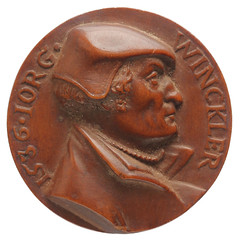 Kerry Wetterstrom writes:
Kerry Wetterstrom writes:
"I enjoyed reading the latest issue of The E-Sylum, and I saw the note on the wooden medallion of George Winckler. Winckler was a Protestant Reformation martyr and I believe he was assassinated in 1527, hence I’m not certain what the date of 1536 signifies. I’m sure you’ll hear from others that know more than I do about Winckler."
So far, Kerry is the only reader to respond. -Editor
To read the earlier E-Sylum article, see:
NOTES FROM E-SYLUM READERS: APRIL 21, 2024 : Query: 1536 IORG WINCKLER Medallic Item
(https://www.coinbooks.org/v27/esylum_v27n16a10.html)
Nashua Coin Club Wins ONA Club of the Year Award
Judy Blackman writes:
"On Saturday, April 20th, 2024, the Nashua Coin Club of New Hampshire was recognized for the THIRD time as the Ontario Numismatic Association’s Club of the Year. NCC has received this award for the years 2021, 2022, and now 2024. This photo taken by Alan Roy, shows (left to right) NCC Secretary Kevin Winn, NCC Director Bob Fritsch, and ONA Club Services Chairperson Stephen Adams."
Congratulations! -Editor
For more information on the Nashua Coin Club, see:
https://nashuacoins.com/nashua-coin-club/
Maintaining Interest and Enjoyment in Collecting
Nick Graver writes:
"I was interviewed the other evening by an officer of the Rochester Numismatic Association coin club. He conducted a Zoom discussion with elder numismatists about when they started collecting coins in the 1950s.
I am member # 1, the longest active member and probably one of the oldest! That happens when you arise each morning.
There were three veterans speaking, two were at the meeting and I was online. We each answered seven questions and then added items that came to mind.
The seventh/last question the moderator asked the three of us was: "considering all the changes in coinage and numismatics over the years, how have you maintained your interest and enjoyment in collecting?"
My joy has come from the history involved, the wonderful people I have met and the traveling we have done. I mentioned E-Sylum, the weekly newsletter produced by fellow Pittsburgher Wayne Homren now living in Northern Virginia. It keeps me learning and meeting new people and topics.
The moderator again mentioned E-Sylum in his wrapup and all the material it contains."
Thanks, and congratulations on reaching #1 status! -Editor
For more on the Rochester Numismatic Association, see:
Rochester Numismatic Association
(http://www.rochesternumismaticassociation.org/)
Bakelite Silver Dollar 25th Wedding Anniversary Plaque
Jim Haas passed along this newspaper clip of an interesting (and expensive) Depression-era wedding anniversary gift. Unfortunately, there's no image of the item. Has anyone encountered such a thing? -Editor
2025 AMERICAN LIBERTY DESIGNS
"Have you seen this Statue of Liberty design that the CCAC is recommending for American silver Liberty for 2025? I wasn't able to get the whole coin in the scan but it looks to me like you'd see it on the side of a train car."
I hadn't seen any of these designs yet. The meeting minutes haven't been posted to the CCAC website yet, but here's what Coin World reported. -Editor
The CCAC’s recommended obverse design for the silver American Liberty medal reimagines the Statue of Liberty in stylized graffiti form. The base of Liberty’s torch is in the shape of a crown that rests on the L in LIBERTY. The crown is at once a tribute to the graffiti art form (the crown is a reference to graffiti artists as kings
of the art form) and an allusion to how Americans converted their rule under a monarchy into their vision of a new nation.
Here are some of the other candidate designs. Follow the link below to see them all. -Editor
To read the Coin World article, see:
American Liberty designs considered for coin and medal
(https://www.coinworld.com/news/us-coins/american-liberty-designs-considered-for-coin-and-meda)
To see all the candidate obverse designs:
CCAC Meeting Images for the 2025 American Liberty Gold Coin and Silver Medal – Obverse
(https://www.usmint.gov/news/ccac-meetings/2025-american-liberty-gold-coin-silver-medal-obverse)
For information on the Citizens Coinage Advisory Committee (CCAC), see:
Citizens Coinage Advisory Committee (CCAC)
(https://www.ccac.gov/)
VOCABULARY TERM: PLANCHET
Here's another entry from Dick Johnson's Encyclopedia of Coin and Medal Terminology. -Editor
Planchet. A round metal disk (or other shape) made for striking into a coin or medal. The term blank is widely used in the metalworking field. Planchet is only used for coins and medals. Likewise, the word flan is French for a coin or medal blank. A planchet is the end product of the rolling and BLANKING operation. It produces a piece of metal of the proper composition, weight, thickness (and diameter if round). Further to make a blank into a planchet requires treatment of the edge[RWB1].
The blanking process, formerly called cutting and cutting-out (particularly in England), leaves a burr on the exit side of the blank. The piece must be deburred. This, plus additional preparatory steps, occur by upsetting in an upsetting mill (British terms rimming
and rimmer
) which thickens the edge, makes the piece perfectly round, in addition to deburring. Since this step work hardens the blank, it must be annealed (or softened), then riddled (to eliminate imperfect blanks) and metal cleaned (to remove all surface contaminants). At this stage the planchet is ready to be fed into the press. All of these steps are required to create perfect blanks for automatic feeding into coining presses (if not they would cause mis-strikes and could jam the press). See blank, blanked, blanking.
A blank planchet is a planchet that has not been struck. If it has not been upset, collectors call this a type one blank, and after it is upset, type two planchet. A better terminology for these two stages would be "blank" for type one, and "press ready planchet" for type two.
To read the complete entry on the Newman Numismatic Portal, see:
Planchet
(https://nnp.wustl.edu/library/dictionarydetail/517312)
NUMISMATIC EXHIBITIONS AT U.S. BANKS
E-Sylum Feature Writer and American Numismatic Biographies author Pete Smith submitted this article on Numismatic Exhibitions at U.S. Banks. Thanks! -Editor
I realized this week that I had written several articles about coin exhibitions at banks. I also realized how common these have been. This week I will offer a review and some additional comments.
Coin clubs have often presented coin exhibits for banks during National Coin Week. I offer someone else the opportunity to catalog those. I would not be surprised it there have been more than a thousand.
The Federal Reserve Bank has had money museums in their branches in Atlanta, Chicago, Cleveland, Denver, Jacksonville, Kansas City, Miami, Richmond, Saint Louis, and San Francisco at various times.
The Chase Manhattan Bank opened their Money Museum at the Chase Bank in 1929 and was later installed at Rockefeller Center until it closed in 1973. They acquired the collection of Farran Zerbe who stayed with the collection as curator. Later curators included Vernon Brown and Gene Hessler. This was the most popular money museum in the United States.
The Mercantile Bank of St. Louis had the Mercantile Money Museum housing items from the collection of Eric P. Newman. They also had a portion of his library available for study.
The Museum of the Money of the American West was formerly the Bank of California Gold Rush Museum. It is now hosted by the Union Bank.
The National Bank of Detroit Money Museum featured the collection of Nate S. Shapiro. It opened April 28, 1960, and closed in 1992. Oscar K. Dodson was the first curator, succeeded by Charles Hoskins. It was noted for a large piece of Yap stone money.
The National Bank of Logansport Indiana had a money museum created by the Logansport Coin Club. It opened April 9, 1971, and is now gone.
The N. A. S. C. Money Museum was created by the Numismatic Association of Southern California. It was initially at the Union Bank in Los Angeles in 1967. It was moved to the Coast Federal Savings and Loan in 1973, and to the Airport Century bank in 1975.
The Union Planters National Bank Money Museum in Memphis featured the collection of P. B. Trotter, a bank vice president. It opened May 1, 1969. It appears the museum was closed by the time Potter died in 1981.
There is often promotional hype when a museum opens but less publicity when it closes.
There are also bank museums that feature the building and the banking business. Some of these may have numismatic content. Wells Fargo recently closed museums in branch banks leaving only the museum in San Francisco.
Banks have frequently promoted coin exhibits at their banks without naming the owner of the collection. It can be understood that most donors would prefer anonymity while a few prefer self-promotion.
Branches of the Federal Reserve Bank have also offered travelling exhibits for local banks. The Federal Reserve Bank of Philadelphia did not have a money museum, but did offer a travelling exhibit.
The Alabama Bankers Association funded a travelling exhibit shown hundreds of times in the state between 1953 and 1977.
The Chase Bank also put the museum on tour at local banks. Catalogs for these exhibits would provide a challenging collecting theme.
Louis Eliasberg put his collection on display at the United States Mint in Philadelphia for the Bicentennial in 1976. He also exhibited at banks in Baltimore, MD, 1950, Chicago, IL, 1956, Philadelphia, PA, 1957, and Richmond, VA, 1958.
Cyrus Phillips, nationally recognized coin collector
and lecturer had an exhibit at Bank of
America branches in Los Angeles in 1957 to 1962. He worked in public relations with the bank
and often showed the exhibit for the opening of new branches. Upon his death in 1989, the bank
purchased his collection. Phillips and his son gave talks about coins to the public more than a
thousand times.
Hal Proskey (son of David) offered an exhibit of biblical coins at a New York bank in 1954.
Oscar G. Schilke offered his travelling exhibit more than a dozen times in New England during 1952 to 1960. He took advantage of the opportunity to buy from the public. As an ANA district secretary, he helped form local clubs, signed up new ANA members and attended many shows in the region.
William F. Sneed, Jr. was a famous numismatist and promoter most frequently seen in Florida. He was most active during 1951 to 1958. His photograph was prominently displayed in the ads. The ads looked like they were placed by Sneed and the bank location was only incidental. In addition to banks, he showed his collection at local department stores.
Coins from the collection of J. W. Wohlenberger were displayed in the window of the Golden State National Bank in 1922. This was mentioned only once.
Farran Zerbe was the most famous American numismatist in the early years of the twentieth century. He exhibited his famous collection at World’s Fairs and Expositions as well as at local banks before the collection was acquired by the Chase Bank.
I know there are people in the ANA who had disputes with him. However, among the general public, more people during his lifetime would have known his name than the name of the then-current ANA President.
I accept that each of these might qualify as a nationally known numismatist.
However, none of
them were famous nationally. Their impact was more on a regional level. They are important for
the hobby in the early second half of the twentieth century for getting out and talking about
numismatics with the general public.
I suspect the most famous American numismatists today have shows on late night TV. They are not showing widow’s mites and Swedish plate money. Rather they are promoting MS-70 silver eagles. Most of their customers do not belong to a local club, have never been to a coin show and do not receive the weekly E-Sylum. I do not consider their influence on the hobby to be positive.
Great list. I was unaware of some of these, and am particularly impressed by the zeal of Cyrus Phillips. Perhaps these showcase opportunities still exist if local collectors and organizations were to pursue them. With the transition away from cash many bank branches are less transactional and more about marketing services to new and existing customers. Maybe a presentation and exhibit about coins and money would be welcomed as a way to draw in potential customers. -Editor
To read earlier E-Sylum articles, see:
SHAPERO, DODSON AND THEIR MONEY MUSEUM
(https://www.coinbooks.org/v26/esylum_v26n48a20.html)
PHOTOS OF THE PHILADELPHIA MINT ELIASBERG COIN COLLECTION EXHIBIT
(https://www.coinbooks.org/esylum_v13n52a08.html)
https://www.coinbooks.org/esylum_v19n13a13.html
(https://www.coinbooks.org/esylum_v19n13a13.html)
OSCAR GOTTLIEB SCHILKE (1903-1965)
(https://www.coinbooks.org/v27/esylum_v27n16a13.html)
THE INFAMOUS GROUX COLLECTION
Bob Van Ryzin published a nice article for Numismatic News on numismatic oddball Daniel Edward Groux and his grandiose plans for disposing of his "famous" collection. Here's an excerpt - see the complete article online. -Editor
 Groux came to America in the 1840s and established himself as a self-proclaimed language teacher and a professor of numismatics. An advertisement that regularly appeared in the Washington (D.C.) Sentinel reads:
Groux came to America in the 1840s and established himself as a self-proclaimed language teacher and a professor of numismatics. An advertisement that regularly appeared in the Washington (D.C.) Sentinel reads: Modern Languages – D.E. Groux, a native of France, teacher of modern languages, especially French, Spanish, and German. Translations made with correctness and punctuality. Professor of Numesmatics [sic], for the classification and explanation of medals and coins.
Groux’s personal collection of ancient through modern coins and medals was heralded as one of the finest, particularly by its owner, whose overly generous valuations thereof were readily accepted in the general press.
Awarding-winning author and researcher Joel Orosz graciously supplied page scans from his Associations
column, Charles Ira Bushnell’s Flandin’s Catalogue of Coins and Medals: Part III, The Daniel E. Groux Broadside Sale, February 15, 1856.
Orosz’s column, a thorough recounting of Groux’s grandiose and mostly ill-fated schemes, appeared in the Autumn 2022 issue of the Numismatic Bibliomania Society’s The Asylum...
Orosz wrote that in 1852 Groux convinced congressman John L. Conger of Michigan to petition Congress to purchase the collection. The petition, according to the March 30, 1852, issue of The Republic, Washington, D.C., was presented in the House of Representatives on March 27 and offered 6,537 coins and medals to be purchased for the Library of Congress. Orosz notes the petition was referred to the Joint Committee on the Library, which was then bombarded by Groux with additional brochures and numismatic articles in his attempt to sell his collection.
This effort having failed, in 1855 Groux turned to a rather unique lottery scheme, which he laid out in a Nov. 17, 1855, pamphlet boldly titled a Catalogue of Medals and Coins for the Disposal of the Best Collection of Medals, Coins, and Numismatic Works in the United States.
Despite Gould’s enthusiasm, it’s believed the lottery never took place.
Writing in the September 1915 issue of The Numismatist, R. W. McLachlan noted we have no record of the complete disposal of the collection in the manner stated.
McLachlan also observed that Groux overvalued his collection, observing with obvious sarcasm, In comparing the values at which the coins are estimated with prices realized at sales today, we can only conclude that foreign coins were much more valuable sixty years ago, than at present.
To read the complete article, see:
The ‘Best Collection’ That Was Never Sold
(https://www.numismaticnews.net/collecting-101/the-best-collection-that-was-never-sold)
ATLAS NUMISMATICS SELECTIONS: APRIL 28, 2024
Atlas Numismatics has updated their website with 234 new coins, medals, and tokens at fixed prices. Selections include the following items. -Editor
1078301 | GREEK. THRACE. Island of Thasos. Struck circa 435-400 BC. AR Stater. NGC AU? (About Uncirculated ?) Strike 5/5 Surface 3/5 Fine Style. 8.80gm. Satyr advancing right, carrying off protesting nymph / Quadripartite incuse square. Le Rider, Thasiennes 6; HGC 6, 334.
Given the star designation by NGC for exceptional eye appeal.
Ex Millennia Collection - Goldberg Auction 46 (31 May 2006) Lot 26.
$6,950
To read the complete item description, see:
https://atlasnumismatics.com/1078301/
1078346 | AUSTRIA. ND (ca. 1683) AV Medallic 10 Ducats. PCGS MS61. By Johann Michael Hoffmann (unsigned). 42mm. 34.73gm. SALVATOR MUNDI. Half-length portrait of Christ with halo / SVB UMBRA (As before) – ALARV TVARV (Under the shadow of Thy wings.) [ MUNUS/ :R · P:/ VIENNENS ] (Vienna city view). City view of Vienna with St. Stephen's Cathedral, crowned double eagle with sword, scepter and orb in the claws, below three lines of writing in decorated cartouche between two shields. Horsky 7023.
Very rare in this quality.
$115,000
To read the complete item description, see:
https://atlasnumismatics.com/1078346/
1078347 | FRANCE. 1781-Dated AV Medal of 18 Ducats Weight. NGC MS63PL (Prooflike). By B. Duvivier. 42mm. 61.04gm. Half-length portraits of Louis XVI and his wife Marie Antoinette, Archduchess of Austria, facing each other / Allegorical figure of France holding the newborn prince; a shield with three lilies to lower right. Médailles françaises S.-278, 22.
To commemorate the birth of the dauphin, Crown Prince Louis Joseph Xavier François.
$67,500
To read the complete item description, see:
https://atlasnumismatics.com/1078347/
1078266 | GERMAN STATES. Bavaria. Ludwig I. 1828 AR Thaler. PCGS
MS64.
LUDWIG I KOENIG VON BAYERN, ZEHN EINE FEINE MARK. Head right /
SEGEN DES HIMMELS. Portraits of royals within circles surround crowned, circled portrait at center. KM 734; Dav.-563; J.-37; Thun.-56; AKS 121.
Blessings of Heaven on the Royal Family.
$2,450
To read the complete item description, see:
https://atlasnumismatics.com/1078266/
1077911 | GREAT BRITAIN. Victoria. (Queen, 1837-1901). 1867 AV Pattern Ducat. NGC PR66? Ultra Cameo. By L. C. Wyon. London mint. Edge: Plain. 3.22gm. VICTORIA D: G: BRITANNIAR: REG: F: D:. Head left / ONE HUNDRED PENCE// DUCAT. Dual denominations within and around wreath' date below. W&R 388 (R4).
Extremely rare; an estimated 11-20 known specimens.
Struck for the first International Monetary Conference, held in Paris in 1867. The
initiative proposed at this assembly was the adoption of a single gold standard,
decimalization and overall international coordination of various currencies. The dual
denominations of 'DUCAT' and 'ONE HUNDRED PENCE' were an attempt to satisfy
these initiatives.
$79,500
To read the complete item description, see:
https://atlasnumismatics.com/1077911/
Updates to their online inventory are issued monthly.
For more information and to sign up for the firm’s monthly newsletter, visit: atlasnumismatics.com
SEDWICK OFFERS FIVE POUND ATOCHA GOLD BAR
Here's the press release for the upcoming Daniel Frank Sedwick, LLC auction sale. Amazing material. -Editor
When the Spanish treasure galleon Nuestra Señora de Atocha sank in 1622 off what is now Key West, Florida, she took down untold treasures in gold and silver. And now a particularly famous piece of treasure from the wreck is crossing the auction block.
One of the largest gold bars ever recovered from a Spanish colonial shipwreck is up for sale on May 7th in an auction conducted by Daniel Frank Sedwick, LLC in Winter Park, Florida.
The gold bar, listed in the sale as lot 96, weighs over 5 pounds (2,274 grams), measures 8-3/4 x 1-1/2 x 3/4, and consists of 17-karat gold mined in the New World. The unique bar features eight circular royal tax stamps bearing the King of Spain’s name as PHILIPPVS III along with five XVII (17-karat) gold fineness markings. The bar also possesses a single foundry and assayer mark reading SEBATN / ESPANOL at the center, a mark that is both unattributed and only found on two gold bars recovered from the Atocha.
The gold bar’s pre-auction estimate is $200,000 and up.
This Atocha gold bar is a crowning treasure piece from the most popular salvaged shipwreck treasure ever,
said Daniel Frank Sedwick, owner and founder of the auction firm. With its high intrinsic value in Spanish colonial gold plus its incredible historical value, it will be a trophy piece for its next owner.
The gold bar was created in the early 1600s at a Spanish colonial foundry processing gold and silver mined throughout South America. After being transported overland to Panama City, this gold bar, among others, was loaded in mid-1622 aboard the Spanish treasure galleon Nuestra Señora de Atocha. The Atocha, a three-masted galleon constructed just two years prior, was to carry a vast treasure of gold and silver ingots, Colombian emeralds, and silver coins all bound for mainland Spain.
When the Atocha departed her final port at Havana, Cuba on September 4th, 1622, she was the almiranta, the lead ship, of the 28-ship 1622 Fleet. The Fleet was a vital link in Spain’s finances as the gold and silver from the New World funded the royal treasuries. In addition to the treasures on board, the Atocha carried her crew along with soldiers and passengers, around 265 people in all, intending to cross the Atlantic Ocean and return to Europe.
Just two days out from Havana, the Fleet was engulfed by a hurricane while approaching the Florida Straits. Amid the storm, the Atocha was wrecked and torn apart upon a reef off the Florida Keys. Only five people survived the sinking, having clung to the highest remaining mast of the ship as it sank. The wreck of the Atocha was further scattered just a month later during another storm, preventing the Spanish colonial authorities from salvaging any of her precious cargo spilled across the ocean floor.
The treasure of the Atocha did not see light again until 1971, when the first coins were found by the now-famous salvager Mel Fisher and his divers. Throughout legal battles and personal tragedies, the salvage group eventually recovered the bulk of the treasure in 1985 and thereby unleashed the largest supply of silver cobs and ingots the market has ever seen.
This gold bar will be auctioned along with its photo-certificate issued by the Fisher salvage company in 1985. The bar also boasts a pedigree to the Christie’s Atocha auction of June 1988 as lot 90.
Other treasures from the Atocha in the upcoming Sedwick auction include:
- a large silver ingot from Oruro weighing over 88 troy pounds (Lot 105) estimated at $30,000 and up.
-
 a silver ingot from Potosí weighing over 82 troy pounds (Lot 106) estimated at $25,000 and up.
a silver ingot from Potosí weighing over 82 troy pounds (Lot 106) estimated at $25,000 and up.
- a very rare silver piña ingot, one of only three known from the Atocha, weighing 5,335 grams (Lot 107) estimated at $15,000 and up.
- over 180 silver coins from Potosí, Mexico City, and Lima including 19 high grade pieces from the Bill Barman Collection of Atocha Research Coins
To have this amazing gold bar alongside all these other treasure pieces from Atocha in a single auction is a feat not seen on this market in decades,
said Sedwick. And it won’t be seen again anytime soon.
The three-day auction will be held live online at auction.sedwickcoins.com.
The Atocha gold bar can be viewed on the auction site here:
https://auction.sedwickcoins.com/Large-gold-ingot-77-2274-grams-marked-with-fineness-XVII-17K-foundry-assayer-cartouche-SEBATN_i52415344
For more information, contact Daniel Frank Sedwick, LLC by email at office@sedwickcoins.com.
NOONAN'S OFFERS OLYMPIC MEDALS
Olympic medals and related ephemera are being offered in May by Noonans Mayfair. Here's the press release. -Editor
The medals and ephemera awarded to Guy Butler, winner of four Olympic medals including a Gold at the 1920 Games are to be sold at Noonans Mayfair in their auction of Historical Medals on Thursday, May 9, 2024. Bell was Britain’s most bemedalled Olympic athlete of all time, a distinction shared since 1984 with Sebastian Coe, Christine Ohuruogu and Mo Farah. Ranging from International including those from the 1920, 1924 and 1928 Olympic Games and regional medals to trophies to blazers, the collection is being sold by his four grandchildren and is expected to fetch £15,000-20,000.
As Peter Preston-Morley commented: We are very pleased to be selling this collection – just two months before the 2024 Olympic Games will be held in Paris. Guy Butler was a truly outstanding athlete who not only won more Olympic medals that any other British Athlete until 1984 when he was caught up by Sebastian Coe! This wasn’t his only feat, he even outran the legendary Harold Abrahams and came third to Eric Liddell, other heroes of the 1924 Olympics, whose feats were celebrated in the 1981 blockbuster film Chariots of Fire.
Guy Montagu Butler (1899-1981), b Harrow, son of Edward Montagu Butler (1866-1948), a former first-class cricketer for Middlesex and housemaster of The Park, Harrow School, and grandson of Dr Henry Montagu Butler (1833-1918), the Head Master of Harrow from 1860 to 1885 and subsequently Master of Trinity College, Cambridge; he was a cousin of the former Home Secretary Rab Butler.
Also included in the sale is the 1952 Olympic Games Winner’s medal awarded to the American swimmer Jimmy McLane in Helsinki, which is estimated at £8,000-10,000. James Price McLane Jr (1930-2020), born in Pittsburgh and raised by a single mother in Akron, Ohio, won a swimming scholarship to the historic Phillips Academy in Andover, Massachusetts, as a result of winning the 4-mile open-air swim at the national Amateur Athletic Union championships in 1943. As a student at Phillips, mentored by Robert Kiphuth (1890-1967), the legendary coach of the Yale swimming team, McLane, known as ‘Fishy’ to his friends, set national high school records in the 200, 220 and 440 yard freestyle events.
For more information, or to bid, see:
https://www.noonans.co.uk/
BANKNOTES OF THE DEUTSCH-ASIATISCHE BANK
Stack's Bowers Director of Consignments and Senior Numismatist Dennis Hengeveld published an article about the banknotes of the Deutsch-Asiatische Bank. -Editor
Like other European nations, Germany tried to expand its presence in the Far East in the second half of the 19th century. In China, Germany took part in the Shanghai International Settlement, an enclave in Shanghai from which European governments were allowed to trade. It was here that in 1889 the Deutsch-Asiatische Bank was founded. It had been in the making for the previous decade, but its establishment had been delayed several times. According to Maximilian Müller-Jabusch in his 50-year history of the bank, the main reason for the initial setup of the bank was to finance railroad construction; when the bank got up and running it became more focused on trade financing. Regardless, it played an important role in the development of railroads in China through its banking. Even though Germany lost its colonies at the conclusion of World War I, the bank continued operating in a much-reduced capacity and was eventually merged with Deutsche Bank in the late 1980s.
Soon after its establishment in 1889 the Deutsch-Asiatische Bank opened branch offices throughout the region. In China, offices were opened in places such as Tianjin, Hankou, Qingdao, Beijing and Guangzhou. Other branch offices were opened in Hong Kong, Yokohama, Singapore and elsewhere. In July 1906, the German government authorized the issuance of banknotes, which were first put into circulation in June 1907 (the first series of notes are dated March 1, 1907). Curiously, there were two different sets of notes. The majority were denominated in (Mexican) Silver Dollars, while a smaller group were denominated in Taels, a traditional Chinese currency that typically circulated in ingot form.
The banknotes were printed in Germany by the printing firm of Giesecke & Devrient. The design was standardized across all denominations, with a seated image of Germania at right and the Imperial Eagle and Chinese Dragon at left on the front. The back design varies among the different denominations. To signify the international nature of the bank, the notes have text in three languages: German, Chinese and English. The banknotes were delivered to the bank fully printed except for the signatures of two bank officials, which were to be placed on the note upon issue.
There were five branches of the Deutsch-Asiatische Bank that issued these notes. Qingdao (Tsingtau in German) had the largest issue, followed by Shanghai, Tientsin, Hankou (Hankow in German) and Beijing (Peking in German). All five branches issued notes denominated in Dollars, while the branches in Shanghai, Peking and Hankow also issued notes denominated in Taels. Dr. Arnold Keller identified a total of 57 notes in the series but does state that some may not exist. A second series with identical design was issued dated July 1, 1914, but it is unclear if any entered circulation. Issued notes are extremely rare for most issues, and most examples in the marketplace today are remainders. The Pick catalog may cause some confusion as these are listed in two different places for no apparent reason; the notes from the Tsingtau office are listed in the general volume under Kiau Chau, while notes from other branches are listed in the specialized volume under China.
The Al Kugel Collection features a large variety of these historic banknotes, the first group of which is offered by Stack’s Bowers Galleries in the Spring 2024 Maastricht Auction. Offerings of the Deutsch-Asiatische Bank include lot 50222, a 1907 1 Dollar Specimen from Tsingtau in PMG Choice Uncirculated 64, lot 50223, a 1907 10 Dollar Specimen from Tsingtau in PMG Choice Uncirculated 63, lot 50224, a 1907 100 Dollar Remainder from Peking in PMG Choice Uncirculated 64 and lot 50225, a 1907 5 Taels Remainder from Peking in PMG About Uncirculated 53. Additional notes from the Al Kugel Collection will be offered in future Stack’s Bowers Galleries auctions. To consign your world paper money alongside this impressive collection please contact Dennis Hengeveld at dennis@stacksbowers.com.
To read the complete article, see:
HISTORY OF THE DEUTSCH-ASIATISCHE BANK AND ITS BANKNOTES
(https://stacksbowers.com/history-of-the-deutsch-asiatische-bank-and-its-banknotes/)
NUMISMATIC NUGGETS: APRIL 28, 2024
Here's a selection of interesting or unusual items I came across in the marketplace this week. Tell us what you think of some of these. -Editor
The Parisii Quarter Stater
Northeast Gaul, The Parisii, Quarter Stater, c. 60-40 BC, BN 7796 R.Northeast Gaul, The Parisii, Quarter Stater, c. 60-40 BC, Traité de numismatique celtique (J-B. Colbert de Beaulieu), Classe V, fig. 21, BN 7796, LT 7796/7798, SLM 273, 1,54 g - highly detailed, immacuately centered and thus one of the best known examples of this extremely rare and important piece of Celtic art and Parisian history.
Already by the end of the 3rd cent BC, a settlement built on the Île de la Cité was inhabited by a Gallic tribe known as the Parisii. Julius Caesar wrote in "Commentarii de Bello Gallico" that the inhabitants would rather burn their town - which Caesar called Luteciam Parisiorum (Lutetia of the Parisii) - than surrender it to the Romans.
From the 30 April 2024 Bonham's sale. -Editor
To read the complete lot description, see:
Northeast Gaul, The Parisii, Quarter Stater, c. 60-40 BC, BN 7796
(https://www.bonhams.com/auction/30401/lot/204/northeast-gaul-the-parisii-quarter-stater-c-60-40-bc-bn-7796/)
St. Thomas Ice Token
Raven & Co., St. Thomas, 1 lb Ice token (istegn) u. år (ca. 1890), messing, Sieg 74
Unusual item. Also from the 30 April 2024 Bonham's sale. -Editor
To read the complete lot description, see:
Raven & Co., St. Thomas, 1 lb Ice token (istegn) u. år (ca. 1890), messing, Sieg 74
(https://www.bonhams.com/auction/30401/lot/160/raven-and-co-st-thomas-1-lb-ice-token-istegn-u-ar-ca-1890-messing-sieg-74/)
Art Directors Club Medal
Art Directors Club Medal in bronze. Sculpted by Paul Manship and struck in 1920 by the Medallic Art Company (MACO). This medal was recently deaccessioned from the American Numismatic Society's collection (1940.100.1951) and has been held in its vaults since 1940. Originally part of the Mr. and Mrs. R. J. Eidlitz collection. Man holding a lyre and pegasus flying over the sun center with ART DIRECTORS CLUB above and INCORPORATED 1920 below on obverse; wreath, man holding a paint palette, and AWARDED FOR SPECIAL MERIT on reverse. Approximately 2.1 inches.
From the American Numismatic Society eBay offerings. This one already sold - sorry. It was hotly contested, with 38 bids. -Editor
To read the complete lot description, see:
1921 Art Directors Club Medal - MACO - Paul Manship - Former ANS Specimen
(https://www.ebay.com/itm/135005010161)
Confederate Half Dollar Scott Restrike Medal
Most of these CSA Scott Restrikes have staining and spotting issues. This is as nice as these can be at this grade level. Some claim to 63. CU = 5150. NET PRICE (Price is firm). 340403 (TV)
Great item. I had one of these in my Civil War collection. From the website stock of Harry Laibstain Rare Coins. -Editor
To read the complete item description, see:
1861 50C CSA SCOTT RESTRI *** PCGS MS62
(http://hlrc.com/Inventory/CoinViewer?id=871518001&c=23)
Isle of Man Card Money
Isle of Man, Card Money, 5 Shillings, Douglas, Philip Killey, Isle of Man Paper Money, first edition 2014, has limited information about Philip Killey, listing the denomination but stating "no information available". This card money note thus represents the first known example of its kind. Extremely rare and a unique collecting opportunity (IOMPM M140b), exceptionally rare and possibly unique
From an upcoming SPINK sale. The description is off - it's a Two Shillings and Sixpence note, not Five Shillings. -Editor
To read the complete lot description, see:
ISLE OF MAN, CARD MONEY, 5 SHILLINGS, DOUGLAS, PHILIP KILLEY, (IOMPM M140B),
(https://live.spink.com/lots/view/4-DH542E/isle-of-man-card-money-5-shillings-douglas-philip-killey-iompm-m140b-)
Engraved Image of Washington
This small banknote engraved image of Washington includes a view of Mount Vernon and the Tomb of Washington. It was designed by H. Billings and "Entered According to Act of Congress 1859 by H. Barnes". Verso has the original paper label attesting to the fact that the frame "was manufactured at the Mount Vernon Factory from wood grown at Mount Vernon." Overall 3 1/4" diameter. Condition: Print and frame in very good condition. Label on verso has a stain and a small loss, though still quite readable.
I'm not sure what the seller means by "banknote engraved image", but it's a great engraving with a medallic portrait and a nice decoration for a numismatic library, office, or coin shop. -Editor
To read the complete lot description, see:
1859 George Washington Engraving Framed with Mt. Vernon Wood
(https://www.abebooks.com/servlet/BookDetailsPL?bi=31840124476)
SWEDISH ISLAND SILVER BRACTEATE HOARD
Paul Horner passed along this article about a find in Sweden of a hoard of 170 silver bracteates, which resemble coins. Thanks. -Editor
Swedish archaeologists recently uncovered a 12th century grave during an archaeological dig – and found buried treasure along with it.
The Jönköping County Museum announced the find in a Mar. 27 press release that was translated from Swedish to English. The discovery happened during an excavation of a grave in an old church in Visingsö, a Swedish island.
The coins were found in the grave of a man that experts believed was between 20 and 25 years old when he died. The pieces of metal were produced between 1150 and 1180.
170 silver bracteates were found in total. A bracteate is a piece of thin, coin-shaped metal that was used as jewelry.
While the find might be seen as just old metal to some, Swedish historians say that the discovery is significant to their field.
"The find is very special, partly because there are few similar finds from the time period, partly because some of the coins are completely unknown from before," the museum said.
"It is a completely sensational find that will change the early medieval coin history in Götaland and shed light on a period that is largely completely unknown," the Royal Coin Cabinet's Eeva Jonsson said in a statement.
To read the complete articles, see:
Archaeologists uncover 850-year-old treasure in ancient grave: 'Sensational find'
(https://www.foxnews.com/lifestyle/archaeologists-uncover-850-year-old-treasure-ancient-grave-sensational-find)
Archaeologists uncover a hoard of 12th-century coin-like objects in Swedish church
(https://www.express.co.uk/news/uk/1891653/archeologists-uncover-coins-Sweden-church)
EURO COIN COUNTERFEITERS CAUGHT
Howard Berlin passed along this story about the dismantling of a counterfeiting ring in Spain that circulated fake two euro coins. Thanks! That's great to hear. -Editor
 On Wednesday, German press agency dpa reported that Spain's National Police had busted a money counterfeiting ring that had allegedly been putting fake €2 coins into circulation all across Europe. With the help of the pan-EU police organization Europol, the Spanish authorities were reportedly able to uncover a counterfeit workshop in the central city of Toledo that they described as "the most important in Europe over the past 10 years."
On Wednesday, German press agency dpa reported that Spain's National Police had busted a money counterfeiting ring that had allegedly been putting fake €2 coins into circulation all across Europe. With the help of the pan-EU police organization Europol, the Spanish authorities were reportedly able to uncover a counterfeit workshop in the central city of Toledo that they described as "the most important in Europe over the past 10 years."
The ring reportedly brought nearly 500,000 coins "of high quality" onto the European market. Ten individuals, all Chinese nationals, were reportedly arrested. Spain's National Police said they had been investigating the case for six years, and described the investigations as "extremely difficult and drawn out, not least because of the secretive nature of the organization, and also the near impossibility of being able to follow a trail, which is characteristic for forged coins."
It is relatively easy to identify counterfeit bills. The security measures that have been implemented by central banks are sophisticated and have been well communicated. Almost everybody is familiar with these "security features," from the security thread to the hologram, the background that is difficult to copy to the paper quality — or at least they think they are familiar with them. There are definitely individuals who will overestimate their identification skills.
It's a little different for coins, since they lack a hologram or a security thread. But even such "petty change" has characteristics that forgers often can't replicate and that are therefore worth paying attention to.
In Germany, the Bundesbank, or Federal Bank, is responsible for making German euro coins. The page on its website entitled "Leitfaden Münzen" (Guidelines Coins) contains descriptions on coin security.
"One doesn't need to be a coin expert to tell counterfeit coins apart from real ones," it reads. The bank provides concrete ways to evaluate coins. This is no problem for professionals, since there is a single Europe-wide test that can be done with a certified coin detection device. "Devices that have been successfully tested are available on the website of the European Commission," reads the bank's page on money testing devices.
Of course, this doesn't help the common person much. So the bank recommends paying attention to "the first impression." On a real coin, the imprinted image clearly rises above the rest of the coin's surface, and all contours can be clearly seen, the bank writes. Caution is called for if this isn't the case: The image on counterfeit coins is often poorly imprinted, while the surface can be scarred and contain spots, flecks, lines or notches, the website says.
Contemporary counterfeits have been around as long as genuine pieces, but generally it is the higher denomination coins as these provide a higher return for the counterfeiter; lower denominations may not be economical to counterfeit in the first place.
I wonder how collectors and cataloguers will treat these in the future - will these fakes find their way into coin books and collections? Given their relative rarity, will the fakes become more valuable than the genuine government-issued pieces? -Editor
To read the complete article, see:
Spain busts counterfeit ring behind fake euro coins
(https://www.dw.com/en/spain-busts-counterfeit-ring-behind-fake-euro-coins/a-68934089?)
EURO BOOK COUNTERFEITERS CAUGHT
And the bibliophiles among us can rejoice in the capture of a gang of book counterfeiters. Thanks to Loren Gatch for passing this along. -Editor
 Works by Russian literary greats such as Alexander Pushkin and Nikolai Gogol were substituted with valueless counterfeits from European libraries.
Works by Russian literary greats such as Alexander Pushkin and Nikolai Gogol were substituted with valueless counterfeits from European libraries.
European authorities say they have rounded up a criminal gang who stole rare antique books worth €2.5 million from libraries across Europe.
In a press release, Europol announced they had arrested nine Georgian nationals in Georgia and Lithuania who are thought to have collaborated in the plot, in which at least 170 books were stolen.
"The thieves would target rare books by mainly Russian writers, such as first editions authored by the likes of Alexander Pushkin or Nikolai Gogol."
The EU Agency for Law Enforcement detailed that the thieves would visit libraries and request to check the antique books in person, feigning a specific reason, such as academic interest.
They would then meticulously measure the books and take photographs before handing them back.
"Several days, weeks, or months later, the perpetrators would return and ask to access the same books, this time returning counterfeit versions. Experts have established that the copies were of outstanding quality," Europol continued.
The swoop on the gang involved more than 100 officers across 27 different locations, and the investigation was backed by authorities from 10 different countries.
More than 150 books were recovered - their provenance is now being established.
To read the complete article, see:
Police rumble gang stealing antique books across Europe
(https://www.euronews.com/2024/04/25/police-rumble-gang-stealing-antique-books-across-europe)
BOY REBUILDS SHREDDED 10,000 YEN BILL
Destroyed banknotes make the news regularly. Here's a story from Japan about a boy's effort to reconstruct a shredded 10,000 yen bill. -Editor
A Japanese boy allegedly spent three weeks piecing back together a 10,000 yen bill like a jigsaw puzzle after it had been accidentally put through a paper shredder.
Japanese Twitter user ‘Tomo’ recently completed one of the hardest puzzles he’s ever done – putting back together a 10,000 yen ($65) bill that had been shredded into thousands of pieces. Apparently, his father accidentally shredded an old envelope at work after forgetting that he had put a 10,000 yen bill in it months ago. Realizing his mistake, the man decided to use his mistake as a challenging project for his son. He took home the entire shredder waste basket and told his son that if he could piece together the shredded bill and exchange it for a new one at the bank, he could keep it. It was a daunting project for even the most avid jigsaw puzzle enthusiast, but one the boy gladly accepted.
Tomo began tackling his father’s challenge in mid-February, by sorting the bill pieces from the other bits of paper. It was harder than it sounds, as some parts of the bill had a lighter tone and could easily be mistaken for plain paper, and there was no way to tell if he found all the pieces.
Then, to give himself a better chance of completing the puzzle, he took another 10,000 yen bill and put it under a sheet of transparent plastic as a reference. Whenever he recognized a piece of the shredded bill, he set it on top of the whole bill to gauge his progress. Even so, working out where every piece fit was very difficult, and he ended up sinking over three weeks into the project.
On March 21st, Tomo shared a photo of the partially reconstructed bill, claiming that it was the best that he could do. It wasn’t perfect, there were bits missing from the lighter edges of the bill, and the rest of it wasn’t in much better shape. However, the Japanese youth was counting on the fact that the Bank of Japan has a very specific policy when it comes to exchanging damaged bills.
To read the complete article, see:
Boy Spends Three Weeks Piecing Together Accidentally Shredded 10,000 Yen Bill
(https://www.odditycentral.com/news/boy-spends-three-weeks-piecing-together-accidentally-shredded-10000-yen-bill.html#google_vignette)
LOOSE CHANGE: APRIL 28, 2024
Here are some additional items in the media this week that may be of interest. -Editor
CoinWeek published a profile of New York City collector J.N.T. Levick. The article illustrates some of the great coins pedigreed to his collection. -Editor
His collection was sold in parcels starting in 1859. Levick built a major token collection focusing on the issues of America’s eastern states, which comprised about 4,000-5,000 pieces (probably second to Groh’s 5,000+-piece collection)—owned a nearly uncirculated example of the 1792 Birch cent (Judd-3) with a plain edge. This coin was sold at Cogan’s 1859 Sale ...
Civil War Veteran; served in New York Volunteers and commissioned a Captain. Proposed publication of a monthly journal – which became the American Journal of Numismatics. Inducted into the ANA Numismatic Hall of Fame in 2018.
To read the complete article, see:
Joseph Napoleon Tricot J.N.T.
Levick : Coin Collector Profile
(https://coinweek.com/joseph-napoleon-tricot-j-n-t-levick-coin-collector-profile/)
Steve Benner published a CoinWeek article on a topic I was unfamiliar with - Roman household Gods on coins. -Editor
Most people who are even remotely familiar with the Roman Empire can name some of the gods that they worshipped. The Olympian gods like Jupiter and Mars, etc. are well known by readers, and many of the non-Olympian gods, like Saturn, Bacchus, Janus, and Bellona, etc., are also familiar. I have written several articles about these gods, both Roman and Greek, on coins, but this article is on the gods that were worshipped in the home, the personal gods of the Roman people, and not state gods (Vesta is the exception, being both state and personal).
There were three main types of household divinity: 1) Penates, gods of the larder, 2) Lares, spirits of the familial ancestors and their territory, and 3) Genii, the spirit of the master of the household. I covered Genii in an earlier article, so I will not be covering them here. This article will cover some of the better-known Roman household gods on coins, but it is not comprehensive, especially considering that the Romans worshipped scores of gods (like Verminus, god of cattle worms).
To read the complete article, see:
Roman Household Gods on Coins
(https://coinweek.com/roman-household-gods-on-coins/)
A Numismatic News article by Rich Giedroyc examines the precipitous drop in the use of checks. -Editor
When someone uses the term ‘cashless society,’ we think of the demise of coins and bank notes. The use of physical cash has declined in recent years, but who would expect the check rather than coins and bank notes to go extinct due to the rise of cashlessness?
According to a Reserve Bank of Australia 2022 survey, transactions involving paper checks make up a mere 0.2 percent of all financial transactions. Consumer payments using checks were half of this figure. The Australian Banking Association indicated paying by check has declined by about 90 percent over the past 10 years.
At the same time, banks now spend more than $5 to process a check. The Australian Treasurer’s office said this fee will increase as the number of checks being written continues to decline.
At the same time, the Reserve Bank of Australia said, The share of bank notes used for transactional purposes is estimated to have fallen by five percentage points since early 2020, while cash use in the shadow economy has increased slightly and the proportion of bank notes that are lost has remained unchanged.
I believe it. While I still use cash for many purposes rather than credit or debit cards (which could expose your cards to unknown potential scammers), for years I've been quite happy to pay all my household bills securely online and very rarely have an occasion to write a check.
Cashiers today wouldn't know how to handle a check even if they were still accepted. They can't even handle their own business's paperwork. Last year at a local car wash the attendant was short on change and printed me a receipt stating that I was owed one dollar, and said I could cash it in next time. Next time I presented it and the attendant on duty looked at me like I was from Mars. "This is weird," he said, before calling a manager - another kid. This one acknowledged that I was indeed owed a dollar but was flummoxed on how to navigate the machine to subtract it from the total owed. He gave up and let me in free. Now I'm sure I'm known there as "that old receipt weirdo." Should have driven an antique car that day. -Editor
To read the complete article, see:
The Demise of Checks is at Hand
(https://www.numismaticnews.net/paper-money/the-demise-of-checks-is-at-hand)
FEATURED WEBSITE: ROCHESTER NUMISMATIC ASSOCIATION
This week's Featured Website is the Rochester Numismatic Association.
Dr. George P. French is credited as the founder of the RNA. He graduated from Columbia Medical College in 1888 and interned at St. Mary's Hospital in Rochester, NY. After a successful private practice of 24 years Dr. French also found time to collect coins, stamps and curios. His numismatic specialty was large U.S. cents and his collection was one of the finest of its kind.
French became the first president of the fledgling RNA organization that boasted 32 charter members. One of the earliest steps that French took was to facilitate the club's membership in the American Numismatic Association, becoming Branch 2, and now ANA Life Club Member #8. The ANA was a mere 21 years old at the time, having been founded in 1891. "Branch" was the designation given to clubs that joined the national organization.
The objective of the association is to foster the pursuit of numismatics as a science, cultivate fraternal relations among collectors and students, acquire and disseminate numismatic knowledge, assist and encourage new collectors and to form and maintain a collection of numismatic items and literature for the education of the members.










